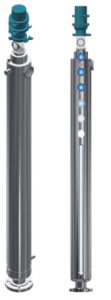
Lynfinity - Freezing
Bulk Dryer: Freezing Technology
Freeze-drying or lyophilization involves removal of solvent such that the molecular structure of the active ingredient of the drug is least disturbed, thus providing a dried product that is quickly and completely rehydrated upon addition of the solvent. Once considered a novelty drug form, there are currently more than 472 FDA-approved drugs supplied as powders requiring reconstitution prior to administration and is estimated to be about half of all injectables (Greystone Research Associates, 2016). Key factors driving growth in lyophilized products over the last decade include rise in number of approved Biologics and growth in self-administered injectables.
It is well known that proteins and peptides often exhibit better stability in solid state than in solution (Cleland et al., 1993). Further, freeze drying is the most common drying technique employed to produce solid protein powders (Yu et al., 2006; Jiang and Nail, 1998; Wang, 2000; Sellers et al., 2001; Carpenter and Manning, 2002; Tang and Pikal, 2004). The stresses associated with freezing and drying during the process have been well documented in (Bhatnagar et al., 2007).
The review described the various stages of freezing and examined consequences of various stresses developed during freezing on protein stability and to assess their relative contribution to the destabilization process.
These stresses for a given formulation are a function of the process and the associated conditions used in processing. Other important processing techniques to generate a dry powder include spray drying and spray freeze drying (Maa at al., 1999; Constantino 2000; 2002). One crucial aspect of the process that exists in both spray drying and spray freeze drying, but not in freeze drying relates to the spraying/rapid freezing process. Each of these process involve spraying through an atomization nozzle. In the case of spray freeze drying, the spraying takes place into a cold environment, typically < -100 °C. The droplets are either frozen during flight under gravity or sprayed into a cryogen bath. Below we briefly describe the freezing technology used in this work.
The stream of liquid droplets is frozen in the freezing chamber cooled using a double walled jacket as shown in figure 1. The freezing chamber itself is located directly above the drying chamber. The freezing chamber is a stainless steel cylindrical vessel with a conical bottom for product transfer to the drying chamber below. Liquid nitrogen and silicone oil cooling jackets are utilized around segments of the freezing chamber for temperature control.

Figure 1: Freezing towet used for spray freezing.
The gas inside the cooling chamber is maintained below -130 °C. Nozzles for liquid product inlet are mounted directly above the freezing chamber shown in blue in figure 1. Prior to initiating product freezing, the freezing chamber is evacuated and back-filled with sterile nitrogen gas. When liquid product is not flowing through the nozzle, nitrogen gas is purged through the product nozzle to prevent freezing.
After conditioning the freezing chamber, the product is sprayed into the chamber through the nozzle mounted at the top of the freezing chamber schematically shown in figure 1 (drops shown not to scale). The liquid product freezes as the stream of droplets falls vertically through the column of cooled gas. Particles freeze as they fall vertically down the freezing chamber. Rapid freezing allows maintaining the spherical shapes obtained from the spraying process. For example, it is estimated that at a gas temperature of -150 °C and a mean volumetric drop diameter of 500 microns, the drop freezes in less than 5 feet from the point of injection into the cooling chamber. Finally, individual frozen droplets collect at the base of the freezing chamber, awaiting transfer to the chamber below.

